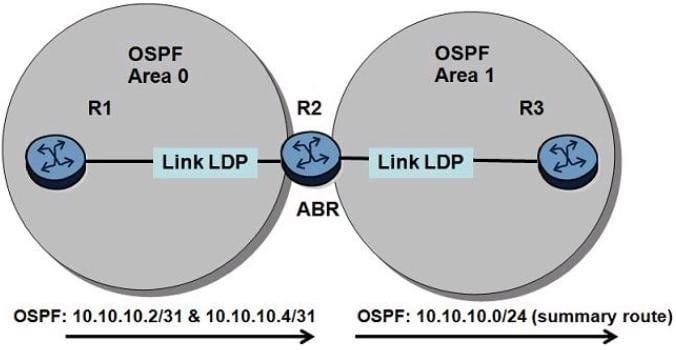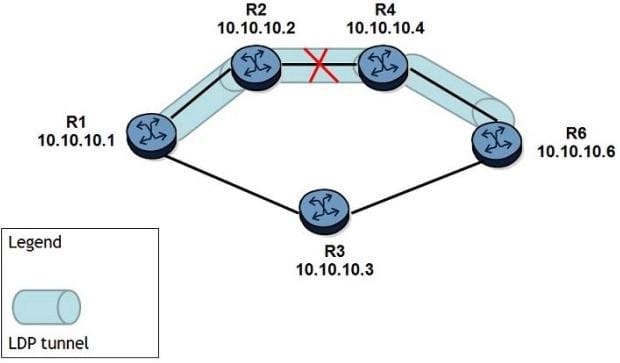Exam Details
Exam Code
:4A0-C01Exam Name
:Nokia NRS II CompositeCertification
:Nokia CertificationsVendor
:NokiaTotal Questions
:922 Q&AsLast Updated
:Apr 11, 2025
Nokia Nokia Certifications 4A0-C01 Questions & Answers
-
Question 281:
Which of the following about Fast Reroute node protection tunnels is FALSE?
A. Node protection tunnels detour around a failed next downstream router.
B. Node protection tunnels can only be requested for a primary LSP path.
C. Node protection tunnels are only used by one-to-one Fast Reroute.
D. Link protection tunnels are established if a router is unable to establish node protection tunnels.
-
Question 282:
Which of the following about the Alcatel-Lucent 7750 SR command "own Isp-trace" is FALSE?
A. The MPLS TTL values are incremented at each request.
B. The router uses MPLS Echo Request packets that are IP-routed.
C. The router collects hop information along the tunnel's path.
D. The router performs an unidirectional LSP test.
-
Question 283:
Click on the exhibit.

Router R2 advertises the aggregate prefix 10.10.10.0/24 into Area 1. Why would LDP aggregate-prefixmatch be enabled on router R3?
A. To reduce the number of LDP sessions
B. To reduce the number of LIB and LFIB entries
C. To bypass the LDP exact prefix match rule
D. To export summarized routes from OSPF to LDP
-
Question 284:
Which of the following LDP message categories is UDP-based?
A. Notification
B. Session
C. Discovery
D. Advertisement
-
Question 285:
Click on the exhibit button below.

Is a routing policy required on PE1 to advertise a CE1's system interface to PE2?
A. Yes. A routing policy is required to advertise routes between PE routers in a VPRN
B. No. A routing policy is not required; the default behavior on the 7750 SR is to advertise all VPRN routes between PE routers.
C. A routing policy is required only when BGP is used as the PE-CE routing protocol, as shown in the exhibit.
D. A CE1 system interface can not be advertised to PE2 since the CE routers are not aware of the VPRN.
-
Question 286:
Which of the following statements is FALSE about the VPN label?
A. The VPN label is signaled between PE devices using MP-BGP.
B. The VPN label is swapped at each P router as a packet crosses the service provider network.
C. The VPN label is also known as the inner label or service label.
D. The VPN label indicates which VPRN a packet should be sent to once it reaches the egress PE.
E. All of the above
F. Only C and D.
-
Question 287:
Click on the exhibit.

An LDP tunnel is established on router R1 towards router R6. The link between routers R2 and R4 goes down. What will happen to the MPLS data traffic to router R6 IMMEDIATELY after the link goes down?
A. MPLS data traffic will be discarded until the IGP finds a new next-hop to router R3.
B. MPLS data traffic will be discarded unless the LDP tunnel has a standby secondary path.
C. MPLS data traffic will not be discarded because router R1 received labels from both next-hops, routers R2 and R3.
D. MPLS data traffic will not be discarded because of fast reroute capability on router R2.
-
Question 288:
Which of the following tasks must be carried out before deleting an Epipe service? (Choose 4)
A. Shut down all SAPs associated with the service.
B. Shut down all SDPs associated with the service.
C. Delete all SAPs and SDPs associated with the service.
D. Shut down all physical ports that are bound to a SAP.
E. Delete the Customer ID.
F. Shut down the service.
-
Question 289:
An LSP is configured with a fully loose path and CSPF is not enabled. An LSR receives the first PATH message for this LSP. Which of the following is NOT performed by the LSR?
A. The LSR regenerates and forwards a new PATH message.
B. The LSR stores the PATH message in the PSB.
C. The LSR forwards the PATH message based on the HOP object in the RSB.
D. The LSR looks up the PATH message's destination IP address in the FIB.
-
Question 290:
Which of the following statements best describes a route target?
A. A route target is a BGP extended community used to identify the VRF table for a prefix at the receiving PE
B. A route target is a mechanism from which VPRN controls the distribution of VPN routing information.
C. Route target attributes are earned in a MP-BGP as attributes of the route.
D. A route target is used by the PE router to identify the VRF that a VPN-lPv4 prefix is associated with.
E. All of the above statements describe a route target
F. None of the above statements describe a route target
Related Exams:
4A0-100
Nokia IP Networks and Services Fundamentals4A0-101
Nokia Interior Routing Protocols4A0-102
Nokia Border Gateway Protocol for Internet Routing4A0-103
Nokia Multiprotocol Label Switching4A0-104
Nokia Services Architecture4A0-105
Nokia Virtual Private LAN Services4A0-106
Nokia Virtual Private Routed Networks4A0-107
Nokia Quality of Service4A0-108
Nokia Multicast Protocols4A0-109
Alcatel-Lucent Triple Play Services
Tips on How to Prepare for the Exams
Nowadays, the certification exams become more and more important and required by more and more enterprises when applying for a job. But how to prepare for the exam effectively? How to prepare for the exam in a short time with less efforts? How to get a ideal result and how to find the most reliable resources? Here on Vcedump.com, you will find all the answers. Vcedump.com provide not only Nokia exam questions, answers and explanations but also complete assistance on your exam preparation and certification application. If you are confused on your 4A0-C01 exam preparations and Nokia certification application, do not hesitate to visit our Vcedump.com to find your solutions here.